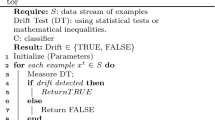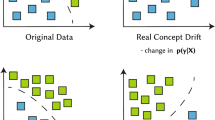Abstract
Drift Detection Method (DDM) emerges as a critical problem faced in the Industry 4.0 era, especially for the identification of concept drift in continuously-gathered data streams. In this study, a small-scale comparison with regard to the impact of different classifiers in DDM is presented. Six well-established classifiers are introduced in order to compare their performance and evaluate their impact on DDM, namely Naïve Bayes (NB), Hoeffding Tree (HT), k-Nearest Neighbors (KNN), Passive Aggressive (PAC), Stochastic Gradient Descent (SGD) and Very Fast Decision Rules (VFDRC) classifiers. Streaming Ensemble Algorithm (SEA dataset) was selected to validate our simulations due to its suitability regarding concept drift detection and handling, incorporating abrupt concept changes. Confusion matrices were used to effectively juxtapose the performance of the considered algorithms in the SEA dataset. The findings suggest that KNN exhibits the best overall accuracy (87%) and seems to be the most stable algorithm compared to NB (86%), HT (86%) and VFDRC (84%) classifiers. Overall, these algorithms show increased performance, while the presence of noise in the data has a significant impact on the model accuracy.
Access this chapter
Tax calculation will be finalised at checkout
Purchases are for personal use only
Similar content being viewed by others
References
Trakadas, P., et al.: An artificial intelligence-based collaboration approach in industrial IoT manufacturing: key concepts, architectural extensions and potential applications. Sensors 20, 5480 (2020)
Angelopoulos, A., et al.: Tackling faults in the industry 4.0 era—a survey of machine-learning solutions and key aspects. Sensors 20, 109 (2020)
Jie, L., Liu, A., Dong, F., Feng, G., Gama, J., Zhang, G.: Learning under concept drift: a review. IEEE Trans. Knowl. Data Eng. 31(12), 2346–2363 (2019). https://doi.org/10.1109/TKDE.2018.2876857
Wares, S., Isaacs, J., Elyan, E.: Data stream mining: methods and challenges for handling concept drift. SN Appl. Sci. 1(11), 1–19 (2019). https://doi.org/10.1007/s42452-019-1433-0
Iwashita, A., Papa, J.: An overview on concept drift learning. IEEE Access 7, 1532–1547 (2019). https://doi.org/10.1109/ACCESS.2018.2886026
Gonçalves, P.M., Jr., de Carvalho Santos, S.G., Barros, R.S., Vieira, D.C.: A comparative study on concept drift detectors. Expert Syst. Appl. 41(18), 8144–8156 (2014). https://doi.org/10.1016/j.eswa.2014.07.019
Liao, J., Zhang, J., Ng, W.W.Y.: Effects of different base classifiers to Learn++ family algorithms for concept drifting and imbalanced pattern classification problems. In: 2016 International Conference on Machine Learning and Cybernetics (ICMLC), Jeju, pp. 99–104 (2016). https://doi.org/10.1109/ICMLC.2016.7860884.
Barros, R., Silas, G., Santos, C.: A large-scale comparison of concept drift detectors. Inf. Sci. 451–452, 348–370 (2018). https://doi.org/10.1016/j.ins.2018.04.014
Maior, R., de Barros, S., de Carvalho, G., Santos, : An overview and comprehensive comparison of ensembles for concept drift. Inf. Fus. 52, 213–244 (2019). https://doi.org/10.1016/j.inffus.2019.03.006
Pedregosa, F., et al.: Scikit-learn: machine learning in python. JMLR 12, 2825–2830 (2011)
Montiel, J., Read, J., Bifet, A., Abdessalem, T.: Scikit-multiflow: a multi-output streaming framework. J. Mach. Learn. Res. 19(72), 1–5 (2018)
Nick Street, W., Kim, Y.S.: A streaming ensemble algorithm (SEA) for large-scale classification. In: Proceedings of the seventh ACM SIGKDD international conference on Knowledge discovery and data mining (KDD ‘01), pp. 377–382. ACM, New York (2001). https://doi.org/10.1145/502512.502568
Gama, J., Medas, P., Castillo, G., Rodrigues, P.P.: Learning with drift detection. SBIA, 286–295 (2004)
Dawid, A.P.: Present position and potential developments: some personal views: statistical theory: the prequential approach. J. Roy. Stat. Soc. Ser. A (Gen.) 147(2), 278–292 (1984). https://doi.org/10.2307/2981683
Author information
Authors and Affiliations
Corresponding author
Editor information
Editors and Affiliations
Rights and permissions
Copyright information
© 2021 The Author(s), under exclusive license to Springer Nature Switzerland AG
About this paper
Cite this paper
Angelopoulos, A. et al. (2021). Impact of Classifiers to Drift Detection Method: A Comparison. In: Iliadis, L., Macintyre, J., Jayne, C., Pimenidis, E. (eds) Proceedings of the 22nd Engineering Applications of Neural Networks Conference. EANN 2021. Proceedings of the International Neural Networks Society, vol 3. Springer, Cham. https://doi.org/10.1007/978-3-030-80568-5_33
Download citation
DOI: https://doi.org/10.1007/978-3-030-80568-5_33
Published:
Publisher Name: Springer, Cham
Print ISBN: 978-3-030-80567-8
Online ISBN: 978-3-030-80568-5
eBook Packages: Intelligent Technologies and RoboticsIntelligent Technologies and Robotics (R0)




